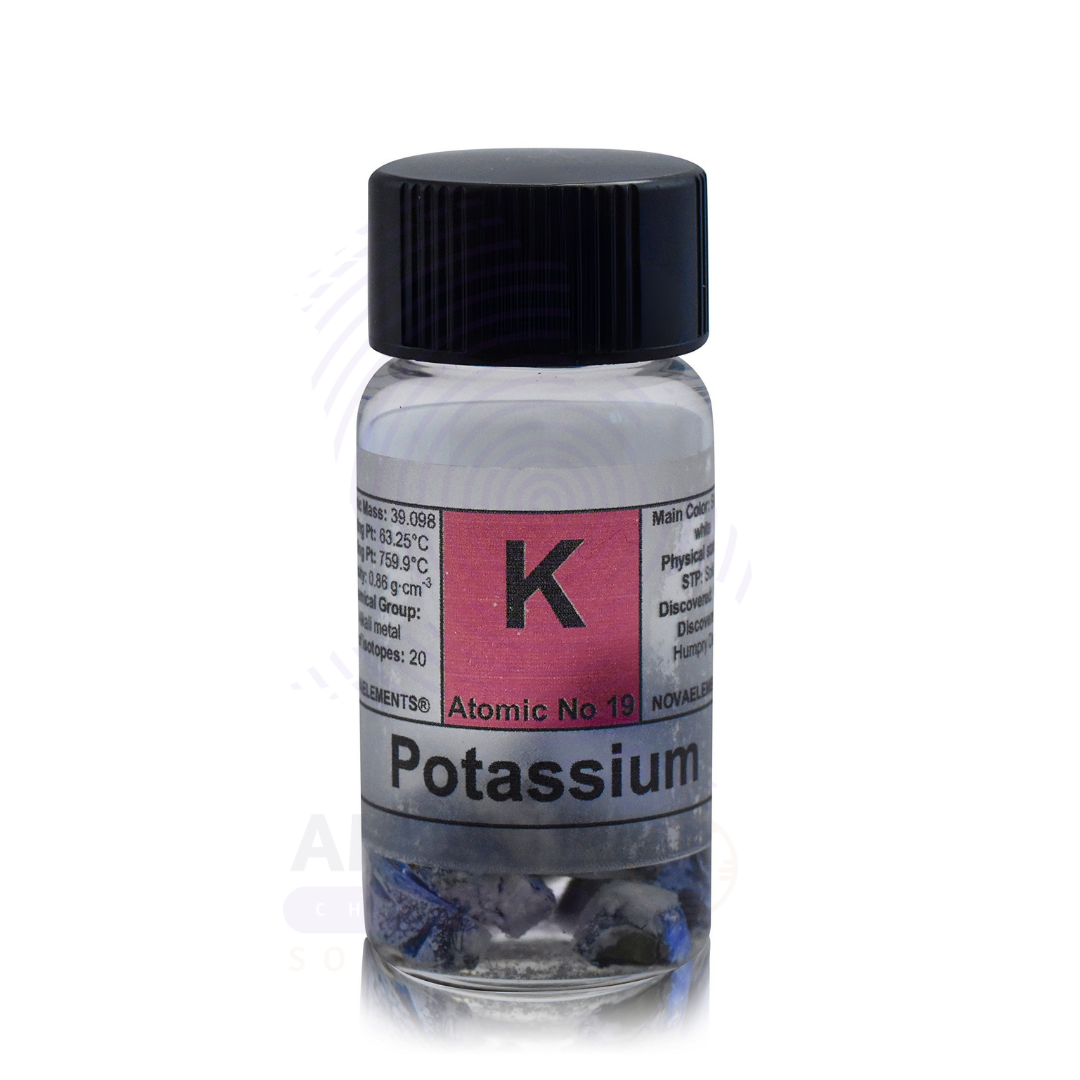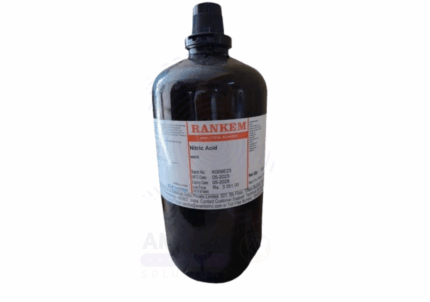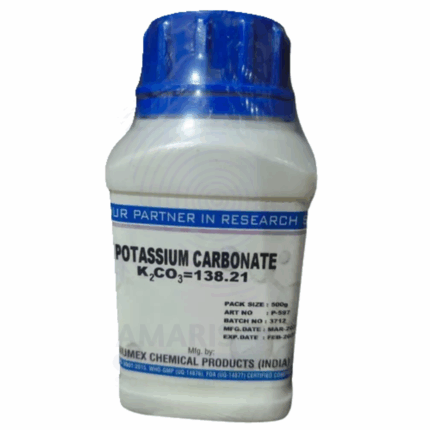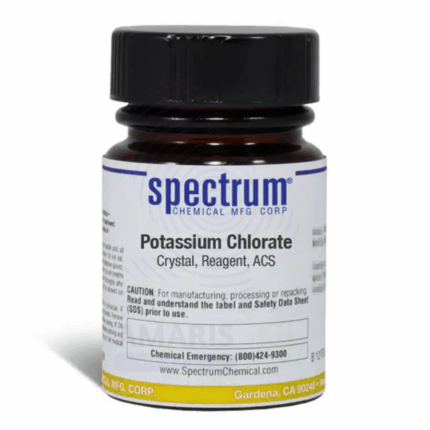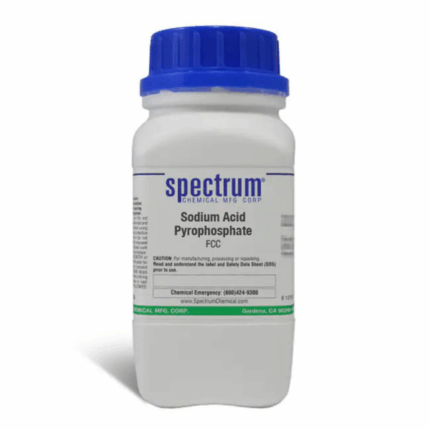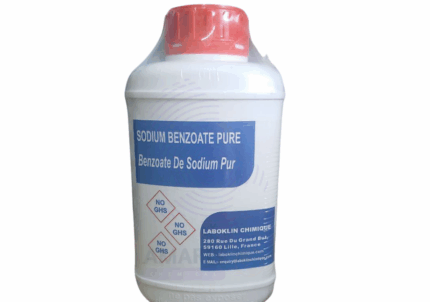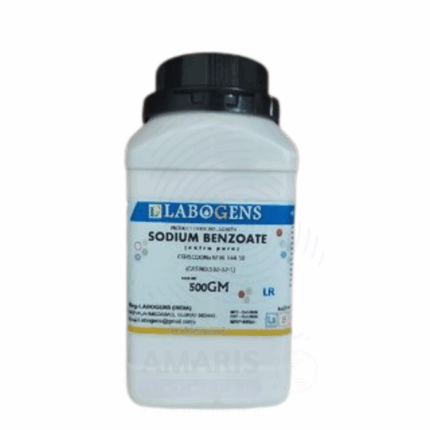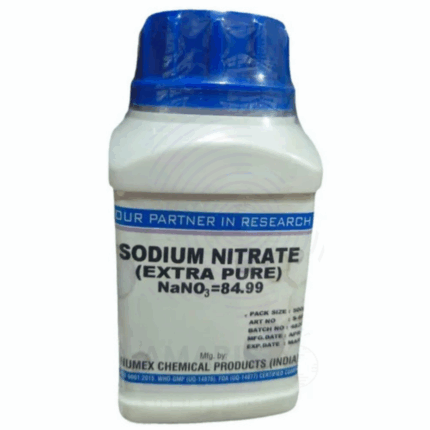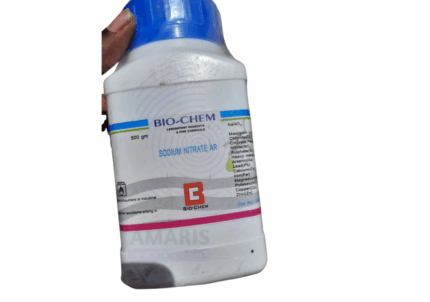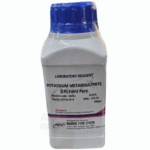

Potassium Metal Extra Pure
$ 17.79 Original price was: $ 17.79.$ 17.67Current price is: $ 17.67.
Potassium Metal Extra Pure is a highly reactive, soft, silvery alkali metal that is typically stored under mineral oil to prevent oxidation. It is primarily used in laboratory demonstrations and synthesis as a powerful reducing agent due to its vigorous reaction with water, producing potassium hydroxide and hydrogen gas. This extra pure grade ensures high chemical integrity, making it ideal for sensitive applications in research, organic chemistry, and material science. Due to its reactivity, it must be handled with extreme caution under controlled conditions and proper safety measures.
Potassium Metal Extra Pure
PRIMARY USES
- Laboratory Reagent:
- Used in scientific research and chemical synthesis for studying reactivity trends of alkali metals.
- Acts as a strong reducing agent in organic and inorganic reactions.
- Production of Potassium Compounds:
- Reacted with other substances to produce potassium hydroxide, potassium superoxide, or potassium alkoxides.
- Heat Transfer Medium:
- In combination with sodium (NaK alloy), used as a liquid metal coolant in some nuclear reactors.
SECONDARY USES
- Metal Reduction in Industry:
- Reduces metal halides (e.g., titanium tetrachloride) to produce pure metals such as titanium or tantalum.
- Organic Synthesis Applications:
- Used in specific reactions like the Birch reduction, where it helps reduce aromatic rings under anhydrous conditions.
- Battery Technology (Experimental):
- Studied for potential use in high-energy density batteries, although reactivity limits commercial deployment.
1. Basic Identification Attributes
- Chemical Name: Potassium
- CAS Number: 7440-09-7
- HS Code: 2805.19.00
- Molecular Formula: K
- Synonyms:
- Metallic potassium
- Elemental potassium
- Kalium (Latin name)
2. Physical & Chemical Properties
- Physical State: Solid (soft, silvery metal)
- Color & Odor: Silvery-white to gray; no significant odor
- Boiling Point & Melting Point:
- Boiling Point: ~759 °C
- Melting Point: ~63.5 °C
- Density/Specific Gravity: ~0.86 g/cm³ (lighter than water)
- Solubility:
- Reacts violently with water
- Insoluble in common organic solvents
- pH Level: Not applicable (elemental metal)
- Vapor Pressure & Volatility: Low at room temperature; vaporizes at high temperatures
- Flash Point: Not applicable (ignites on contact with water)
- Autoignition Temperature: ~250 °C (in air)
- Viscosity: Not applicable (solid)
3. Safety & Hazard Attributes
- Hazard Class (GHS Classification):
- Water-reactive
- Flammable solid
- Corrosive to skin and eyes
- NFPA Ratings:
- Health: 3
- Flammability: 3
- Reactivity: 3
- Exposure Limits:
- No established TLV or PEL for elemental potassium
- Must avoid inhalation of combustion products (e.g., potassium oxide)
- Reactivity:
- Reacts explosively with water, acids, and moist air
- Forms potassium hydroxide and hydrogen gas (which may ignite)
4. Storage & Handling Attributes
- Storage Conditions:
- Store under dry mineral oil, kerosene, or inert gas (argon)
- Keep tightly sealed in an inert atmosphere
- Store in a cool, dry, flameproof cabinet
- Incompatible Materials:
- Water, acids, halogens, oxidizing agents, alcohols
- Container Type:
- Airtight glass or stainless steel containers submerged in oil
- Shelf Life & Expiration Date:
- Stable indefinitely under inert storage conditions
- Special Handling Requirements:
- Use under dry inert gas or oil
- Gloves, goggles, lab coat, and face shield recommended
- Handle with non-sparking tools only
5. Regulatory & Compliance Attributes
- Regulatory Status:
- Regulated under DOT, OSHA, and EU REACH
- Controlled for transport as a dangerous substance
- Transportation Restrictions:
- UN Number: UN 2257
- Hazard Class: 4.3 (Dangerous When Wet)
- Packing Group: I
- Waste Disposal Method:
- Quench small amounts carefully under mineral oil with isopropanol (by trained personnel)
- Dispose through a licensed hazardous waste contractor
6. Environmental & Health Impact
- Ecotoxicity:
- Highly toxic to aquatic life due to reaction with water
- Reacts to form strong bases (KOH), altering water pH
- Persistence in Environment:
- Not persistent; reacts rapidly with moisture
- Carcinogenicity/Mutagenicity:
- Not classified as carcinogenic or mutagenic
- Biodegradability:
- Not biodegradable; reacts chemically to form potassium hydroxide
SAFETY PRECAUTIONS
Personal Protective Equipment (PPE):
- Flame-resistant lab coat
- Nitrile gloves (use with caution; inspect for integrity)
- Safety goggles or full face shield
- Use under inert atmosphere in a glove box or dry, inert gas-purged enclosure
Handling:
- Handle only under dry, inert atmosphere (e.g., nitrogen or argon)
- Avoid contact with water, air, acids, and oxidizers
- Do not touch with bare hands — reacts violently with moisture
- Keep away from heat, sparks, and sources of ignition
Storage:
- Store under mineral oil or in sealed containers under inert gas
- Keep in a cool, dry, well-ventilated, fireproof area
- Keep away from incompatible materials (water, alcohols, halogens)
- Never store in glass containers with ground-glass stoppers
FIRST AID MEASURES
Inhalation:
- Remove to fresh air immediately
- Provide oxygen if breathing is difficult
- Seek immediate medical attention
Skin Contact:
- May cause severe burns — rinse with copious amounts of water if possible
- Do not apply oil or ointment
- Remove contaminated clothing
- Seek emergency medical help immediately
Eye Contact:
- Rinse immediately with water for at least 15 minutes
- Hold eyelids open while flushing
- Urgent medical attention required
Ingestion:
- DO NOT INDUCE VOMITING
- Rinse mouth with water if conscious
- Give nothing by mouth and seek emergency help immediately
FIRE FIGHTING MEASURES
Flammability:
- Highly flammable and reactive — ignites spontaneously in moist air
Extinguishing Media:
- DO NOT use water, CO₂, or foam
- Use Class D dry powder extinguishers (e.g., graphite, dry sand, sodium chloride)
Hazardous Combustion Products:
- Potassium oxide fumes, explosive hydrogen gas
Firefighter Protection:
- Full protective gear and self-contained breathing apparatus (SCBA)
- Approach from upwind
- Use extreme caution — may reignite after extinguishing


 Preservatives(food)
Preservatives(food) Flavor Enhancers
Flavor Enhancers Acidulants
Acidulants Sweeteners
Sweeteners Antioxidants
Antioxidants Colorants(food)
Colorants(food) Nutraceutical Ingredients (food)
Nutraceutical Ingredients (food) Nutrient Supplements
Nutrient Supplements Emulsifiers
Emulsifiers
 Collectors
Collectors Dust Suppressants
Dust Suppressants Explosives and Blasting Agents
Explosives and Blasting Agents Flocculants and Coagulants
Flocculants and Coagulants Frothers
Frothers Leaching Agents
Leaching Agents pH Modifiers
pH Modifiers Precious Metal Extraction Agents
Precious Metal Extraction Agents
 Antioxidants(plastic)
Antioxidants(plastic) Colorants (Pigments, Dyes)
Colorants (Pigments, Dyes) Fillers and Reinforcements
Fillers and Reinforcements Flame Retardants
Flame Retardants Monomers
Monomers Plasticizers
Plasticizers Polymerization Initiators
Polymerization Initiators Stabilizers (UV, Heat)
Stabilizers (UV, Heat)
 Antifoaming Agents
Antifoaming Agents Chelating Agents
Chelating Agents Coagulants and Flocculants
Coagulants and Flocculants Corrosion Inhibitors
Corrosion Inhibitors Disinfectants and Biocides
Disinfectants and Biocides Oxidizing Agents
Oxidizing Agents pH Adjusters
pH Adjusters Scale Inhibitors( water)
Scale Inhibitors( water)
 Antioxidants(cosmetic)
Antioxidants(cosmetic) Emollients
Emollients Fragrances and Essential Oils
Fragrances and Essential Oils Humectants
Humectants Preservatives
Preservatives Surfactants(cosmetic)
Surfactants(cosmetic) Thickeners
Thickeners UV Filters
UV Filters
 Fertilizers
Fertilizers Soil Conditioners
Soil Conditioners Plant Growth Regulators
Plant Growth Regulators Animal Feed Additives
Animal Feed Additives Biostimulants
Biostimulants Pesticides (Herbicides, Insecticides, Fungicides)
Pesticides (Herbicides, Insecticides, Fungicides)
 Active Pharmaceutical Ingredients (APIs)
Active Pharmaceutical Ingredients (APIs) Excipients
Excipients Solvents(pharmaceutical)
Solvents(pharmaceutical) Antibiotics
Antibiotics Antiseptics and Disinfectants
Antiseptics and Disinfectants Vaccine Adjuvants
Vaccine Adjuvants Nutraceutical Ingredients (pharmaceutical)
Nutraceutical Ingredients (pharmaceutical) Analgesics & Antipyretics
Analgesics & Antipyretics
 Analytical Reagents
Analytical Reagents Solvents(lab)
Solvents(lab) Chromatography Chemicals
Chromatography Chemicals Spectroscopy Reagents
Spectroscopy Reagents microbiology-and-cell-culture-reagents
microbiology-and-cell-culture-reagents Molecular Biology Reagents
Molecular Biology Reagents Biochemical Reagents
Biochemical Reagents Inorganic and Organic Standards
Inorganic and Organic Standards Laboratory Safety Chemicals
Laboratory Safety Chemicals Specialty Laboratory Chemicals(Special Laboratory Equipment)
Specialty Laboratory Chemicals(Special Laboratory Equipment)
 Demulsifiers
Demulsifiers Hydraulic Fracturing Fluids
Hydraulic Fracturing Fluids Scale Inhibitors(oil)
Scale Inhibitors(oil) Surfactants(oil)
Surfactants(oil) Drilling Fluids
Drilling Fluids
 Dyes and Pigments
Dyes and Pigments Bleaching Agents
Bleaching Agents Softening Agents
Softening Agents Finishing Agents
Finishing Agents Antistatic Agents
Antistatic Agents
 Admixtures
Admixtures Waterproofing Agents
Waterproofing Agents Sealants and Adhesives
Sealants and Adhesives Curing Compounds
Curing Compounds Concrete Repair Chemicals
Concrete Repair Chemicals Anti-Corrosion Coatings
Anti-Corrosion Coatings
 Surfactants(cleaning)
Surfactants(cleaning) Builders
Builders Enzymes
Enzymes Solvents (Cleaning)
Solvents (Cleaning) Fragrances
Fragrances
 Electronic Chemicals
Electronic Chemicals Catalysts
Catalysts Lubricants
Lubricants Photographic Chemicals
Photographic Chemicals Refrigerants
Refrigerants Automotive chemicals
Automotive chemicals Pyrotechnic Chemicals
Pyrotechnic Chemicals
 Biodegradable Surfactants
Biodegradable Surfactants Bio-based Solvents
Bio-based Solvents Renewable Polymers
Renewable Polymers Carbon Capture Chemicals
Carbon Capture Chemicals Wastewater Treatment Chemicals
Wastewater Treatment Chemicals
 Pigments
Pigments Solvents(paint)
Solvents(paint) Specialty Coatings
Specialty Coatings Binders/Resins
Binders/Resins Additives
Additives Driers
Driers Anti-Corrosion Agents
Anti-Corrosion Agents Functional Coatings
Functional Coatings Application-Specific Coatings
Application-Specific Coatings
 Fresh Herbs
Fresh Herbs Ground Spices
Ground Spices Whole Spices
Whole Spices Spice Blends
Spice Blends Dried Herbs
Dried Herbs
 Leavening Agents
Leavening Agents Dough Conditioners
Dough Conditioners Flour Treatments
Flour Treatments Fat Replacers
Fat Replacers Decoratives
Decoratives Preservatives(baking)
Preservatives(baking)
 Plasticizers & Softeners
Plasticizers & Softeners Reinforcing Agents
Reinforcing Agents Adhesion Promoters
Adhesion Promoters Vulcanizing Agents
Vulcanizing Agents Antidegradants
Antidegradants Blowing Agents
Blowing Agents Fillers & Extenders
Fillers & Extenders Accelerators & Retarders
Accelerators & Retarders